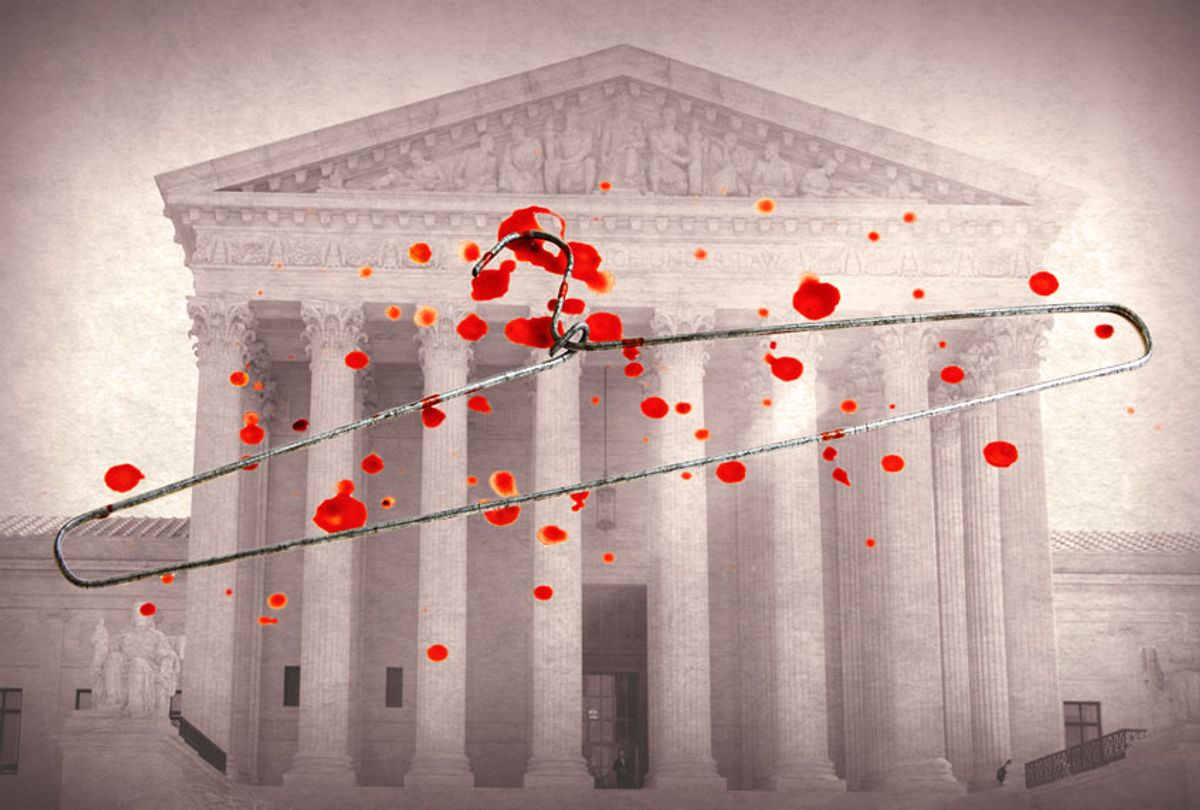My friend and I drew up to a drab brown brick building. An older man, shrunken and slouched, opened the door furtively. We climbed a flight of stairs in a putrid green escape well and emerged into a hallway, then entered a dark apartment. I imagined fleeing down the stairs but then considered the consequences.
"Wait here," the man commanded. After a few minutes he re-emerged from another room and asked me some questions. I tried to stay calm. I felt as if I were sinking into a huge hole from which I might never emerge. "Come with me," he said, leading me into what must have been a kitchen. It had a table in the center of the room, at the foot of which, between stirrups, was a lamp on a stand, and a stool. The table was covered with a sheet of white paper with a thin pillow on it. Next to it was a tray bearing silver instruments and a large jar. The man told me to take off everything from the waist down. There was no privacy screen. I asked him for something to cover myself. "You won't need that," he said. "Just get on the table."
He put my feet into the cold stirrups. I'd never been exposed like that. I felt dirty, naked into my soul. I shivered uncontrollably. He handed me a towel, but no blanket. I wondered if he would wash his hands or put on gloves. I stared at the ceiling, tears dripping from my eyes. Why wasn't there a nurse, I wondered? He came toward me with a wad of gauze in his hand. "Breathe," he said, forcing the gauze down on my mouth. I thought I would suffocate.
RELATED: When SCOTUS guts Roe: The covert plan to provide abortion pills on demand – and avoid prosecution
Then I woke up, still on the table, legs straight, a sheet over me. Pain burned between my legs. I felt as if my stomach had been pulled out of me. The man fiddled with instruments. I heard a whimper and realized it came from me. I passed out. When I woke, the man said, "You need to get up and leave. Get dressed." He handed me a sanitary pad. I rose slowly, waiting for the dizziness to stop. The pad I had shoved between my legs felt saturated already. I hoped I wouldn't die.
* * *
That did not, in fact, happen to me. I imagined that scene for a novel I was writing. My character was one of the lucky ones: She did not die from a back-alley abortion. I was lucky too, because despite a few scares I never needed an abortion. But I knew lots of women who did. I covered for a friend who had to flee the U.S. to get one, and because I worked in women's health I knew where to refer my friends, single and married, for safe abortions.
Now here we are again, having just passed the 49th anniversary of the Roe v. Wade decision, which gave women agency over their bodies and their lives. It is inconceivable for those of us who remember life before legal abortion and who fought hard for reproductive control to find ourselves back in the trenches, fighting for the sovereignty of self as the Supreme Court drags us backward, starting with the Court's support of a draconian abortion law enacted in Texas, soon to be followed by similar laws in as many as two dozen other states, according to the Guttmacher Institute.
The court's shocking decisions and its collective lack of knowledge about, or regard for, women's lives and the role that reproductive autonomy plays in those lives is staggering. This court apparently views abortion as an easy method of birth control instead of a deeply difficult choice, and adoption as a good way out of parental responsibility. It's a court that has no concept of pregnancy confirmation, fetal viability or the lifelong trauma of rape and incest.
Want a daily wrap-up of all the news and commentary Salon has to offer? Subscribe to our morning newsletter, Crash Course.
Neither does the court have a clue or a care that without safe abortion there will still be unsafe abortion resulting in death, irreparable psychological harm and possible suicides among women of childbearing age. Many other women will be deprived of economic security, quality of life aspirations or the fulfillment of life goals.
"The erosion of reproductive rights is a result of raw, bare-knuckled politics, of a minority exercising their power over a majority," Cecile Richards, past president of Planned Parenthood, wrote in a New York Times essay after the court's latest decision regarding SB8, the Texas law that limits abortion. "The millions of Americans who are watching, horrified, as the Supreme Court prepares to roll back a right they have had for nearly half a century need to be just as dogged and determined. But it's going to take unprecedented levels of political activism to fight back."
Perhaps it is Justice Sonia Sotomayor whose words ring out most clearly. "This case is a disaster for the rule of law," Sotomayor wrote in a dissenting opinion. "It allows the State yet again to extend the deprivation of the federal constitutional rights of its citizens through procedural manipulation. The Court may look the other way, but I cannot."
Nor can the millions of women who will pay the price of this cruel procedural manipulation.
Read more on the downfall of Roe v. Wade and the fight for reproductive justice:

Shares